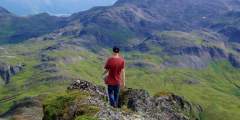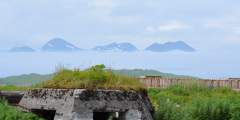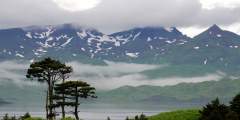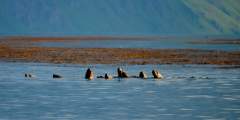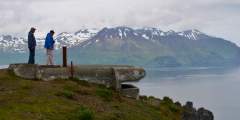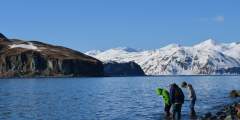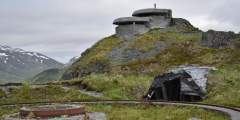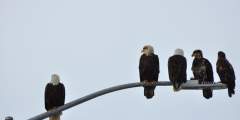Birding Locations in Unalaska
Visitors who come to Unalaska for birding are rarely disappointed. Birds are plentiful, the chances of seeing something unusual are high, and adding several species to your life-list is easy and oh-so-satisfying.
Several factors make Unalaska one of the world’s birding hot spots:
Millions and millions of birds
The sheer numbers of birds in the Bering Sea is staggering. Between 40 and 50 million seabirds feed and make nests here each summer. In winter, the bays around Unalaska are filled with migratory seabirds and waterfowl from the north, who are attracted to the ice-free coastal waters.
Diversity
Not only are there a lot of birds in Unalaska, there is also variety. More than 150 different species can be found here through the seasons. Songbirds. Seabirds. Shorebirds. Resident birds. Nesting birds. Migratory birds. It truly is a birder’s paradise.
Accessibility and ease of viewing
Unalaska is the most accessible of the Aleutian islands, so while you could have similar birding opportunities on the far-western islands of Attu or Shemya, you wouldn’t have the same travel or accommodation options. And many of Unalaska’s birds are easy to spot just by driving along its 42 miles of roads or walking its beaches.
Rare sightings
The Aleutians are home to a number of “Beringian endemics,” or land and sea birds of the Bering Sea that are rarely seen outside this area. These include one of the country’s rarest songbirds – McKay’s Bunting – as well as the Whiskered Auklet, Red-legged Kittiwake, Steller’s Eider and Emperor Goose.
And “mega-rare” sightings!
Birds from Asia regularly get caught up in storms and blown off course, winding up in the Aleutians. The Eurasian Siskin found its way to Unalaska just that way in 2014, attracting visitors from all over the country to see this “Code 5” bird for themselves. Code 6 birds are extinct, which gives you an idea how cool it was for the small town of Unalaska to host a Code 5 bird.
Much more to see
If you haven’t been successful in converting your family members to a birding way of life, you can sell them on an Unalaska trip for many of its other virtues. Visitors are often surprised at how pretty it is herewith rolling green hills, broad sandy beaches, and stunning snow-capped peaks. On a birding excursion, you might also see wildlife (sea lions, otters, whales) and World War II historical remnants. The Museum of the Aleutians, World War II Visitor’s Center, and the Russian Orthodox Church are all popular and fascinating tourist destinations. And a trip to the docks is usually appealing to both birders and fans of the hit show Deadliest Catch – one spots for birds, and the other for well-known crabbing vessels.
Tips:
- Plan ahead. See this bird list to find out what time of year your “must-have” species is likely to be spotted.
- Spend more than a day. You can spot quite a few birds in just one outing, but to maximize your viewing potential, stay for a few days and explore more.
- Get a land access permit and a land ownership map. While the roadways are public access, much of the land you’ll see is in private ownership. You can get a land ownership map from the Convention and Visitor’s Bureau, and an access permit from Ounalashka Corporation (400 Salmon Way) during weekday working hours or at the World War II Visitor’s Center.
- Rent a car. Since Unalaska birding is best in the winter, it can be a chilly affair. “Car-birding” is a popular way to keep warm. Just rent a car, crank the heat, roll down your windows and spot away. (Be sure to pull over before you look through those binoculars, though!)
- Stick to roadways and beaches. You can see many species from roadways and beaches. Old military roads make it easy to wander around without getting lost or wet, and you can get maps to these roads at the Convention and Visitors Bureau. Avoid overland trekking or trails unless you’re with a guide who knows the area. Rain and fog can reduce visibility and disorient you – and the high, lush vegetation will quickly soak your feet and pants.
- Dress in layers. It’s the Aleutians, after all: frequently wet, cold and windy with rapidly changing conditions.
Show Map
Birding Locations
The 2,300-foot Pyramid Peak is surrounded by Pyramid Valley, Captains Bay and miles of popular hiking trails, including a circuit around the peak. This location is for the birder who wants to get out of the city and industrial areas of town to listen for birdsong while sitting among the wildflowers or berries of the Aleutian tundra.
Some of the most valuable seabird habitat in the eastern Aleutians is located about 16 miles from Unalaska, east between Akutan and Unalga islands. The group of five volcanic islands are small, but are important nesting grounds for some species that are rarely seen elsewhere.
The “S‑curves” of Airport Beach Road are well-known by locals as a great place to watch for water birds and for whales. Pull off between the Dutch Harbor Post Office and Gilman Way, and start adding to your life-list!
Locals love the drive along Summer Bay Road, a 7‑mile stretch north of town on the western shore of Unalaska Island. This area, with coves and rolling green hills, is not only picturesque, but serves as an easily accessible place to watch for a good mix of birds — from seabirds and waterfowl to nesting eagles and breeding songbirds. (Except for winter, when the road might be closed due to snow or avalanche risk).
A wide variety of birds and marine wildlife can be seen in Unalaska Bay. Tour by charter boat, or join a guided sea kayaking tour, where your guide can help you spot sea otters, Steller sea lions, and humpbacks.
Tens of thousands of pots are stacked and stored in yards in between crabbing seasons. The towering stacks are a source of shelter, especially for birds that don’t normally live in Unalaska. Crab pot yards are on private property, but you may be able to view from the road or get permission to walk around.
The bald eagle population on Unalaska has fluctuated over the years, and has sometimes been as high as 700. Here, these birds of prey are as plentiful as pigeons are in other cities, giving visitors a rare opportunity to observe our national symbol up close.
Also known as Second Priest Rock, Little Priest Rock is a large, pointed rock easily spotted near the entrance to Summer Bay. Birds perch on the top and on shorter rocks nearby (many just above the surface of the water). Little Priest Rock attracts many seabirds and shorebirds, including bald eagles, puffins, Emperor Geese, grebes and loons.
Some birds that wind up in Unalaska are “accidentals” that have been blown off course by storms. If they are used to living in forests, there’s only one place to head: Sitka Spruce Park, known to local birders as a “migrant trap” for unusual birds.
Jutting half a mile into the center of Unalaska Bay, the Dutch Harbor Spit offers a short, sea-level hike for all ages, with beach access, wildlife viewing and birding. The trail follows an old roadbed, which makes for an ideal hiking surface. You’ll want to stop frequently with a ready camera for close-up views of marine mammals on either side of the spit.
A drive or walk up Mt. Ballyhoo is interesting for both birders and those interested in World War II history. It’s such as good view that you might even catch sight of whales in the distance. The view from the 1,634-foot mountain gives you an idea of how birds might see the area (that is, if you can imagine the view with a lot more color and super-sharp clarity)
Unalaska’s Front Beach, on the shores of Iliuliuk Bay, is both inviting and picturesque. Looking toward the bay, watch for boats coming into harbor, eagles fighting over salmon, or mist engulfing the surrounding hills and mountain tops. Back toward Unalaska, you’ll find more emerald green mountain views and historic sites.
If your travel group includes a WWII enthusiast, a wildlife devotee, a birder, and a kid who enjoys rolling around on the tundra, Bunker Hill is the perfect spot. Plus, it has the best photo ops, with a 360-degree view of the entire area: Captains Bay, Amaknak Island, Unalaska Bay and Iliuliuk Harbor.
Chelan Banks is an area where the Bering Sea and Unalaska Bay meet. Fish are plentiful in this upwelling — a real buffet for the birds! You could see thousands of shearwaters, albatross, the rare short-tailed albatross and the very rare mottled petrel.
The mild stroll around Strawberry Hill offers great views, wildlife and some historic flavor. Old military roads cover the area, providing easy walking. Adventurers can bushwhack or scramble short distances for better views of the surrounding area or get up close to WWII-era trenches and the remains of old bunkers.

